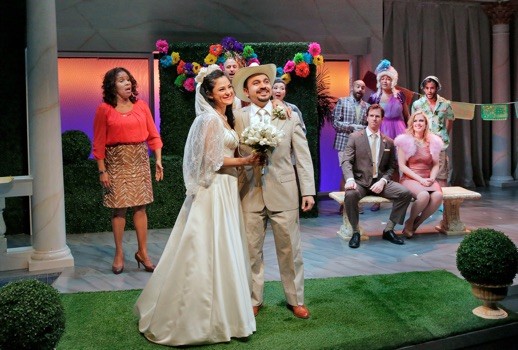
So maybe it takes a fresh look at Mozart’s Le Nozze di Figaro to see how clearly Beaumarchais’ Siècle des Lumières shines fresh light on our current cultural and political predicaments. ¡Figaro! (90210) is currently offering such an opportunity, playing a limited engagement through April 3 at the Duke on 42nd Street.
¡Figaro! (90210), as you might have guessed, is a shortened re-contextualization of Mozart’s operatic warhorse, Le nozze di Figaro, set in present-day Beverly Hills. While much of Mozart’s music is retained, the libretto by Vid Guerrerio (part English, part Spanglish) plays fast and loose with Da Ponte’s Italian original.
In Guerrerio’s rendition, Figaro and Susanna are now Mexican immigrants without green cards. They work under the capricious patronage of Paul Conti, a wealthy American real estate magnate, and his wife Roxanne, a former Hollywood leading lady.
Nozze’s lustful Cherubino is embodied here as a Li’l B-Man, an African-American teenager looking to break into the hip-hop music industry, while Bartolo and Marcellina are reconfigured as the plotting Babayan and Ms. Soon-Yi Nam, an Armenian Mafioso and a Korean factory owner. Inspired by Mozart’s Basilio, Guerrerio’s Basel is a flippant SAT and English Tutor, employed by the Contis to teach their emotional teenaged daughter Barbara.
Guerrerio’s modernization of Nozze is a clever conceit, and his libretto is not as pedestrian as one might fear. In fact, this permutation of the Beaumarchais source material allows the plot to brim with immediacy, thrusting to the forefront the more uncomfortable elements the opera explores.
By racializing the characters, Guerrerio draws out the darker, more disturbing elements that lie latent within the original: humiliation, exploitation, economic inequality, and sexism. Furthermore, Guerrerio has a fine ear for rhyme, utilizing the metrics of Mozart’s music to compose a vital, and at times appropriately vulgar, poetry.

And the precisely shaded characters of Mozart’s opera are reduced here to stereotypes and caricatures that border on offensive (Michael Kuhn’s flamboyant—dare I say, gay—Basel is particularly egregious.)
The one member of the cast to avoid such pitfalls, fortunately, is the eponymous hero. José Adán Pérez’s characterization of Figaro is charming, fully imagined, and engaging; moreover, he manages to be funny in all the right places, while never sacrificing the gravitas of Figaro’s plight. In equal measure, his singing is pleasant and competent, deploying vocal oomph when necessary.
As his bride, Susana, Samarie Alicea is less successful. Her voice lacks the spinning luster we associate with this soubrette role. And she tends toward theatrical tics and habits, gesturing, nodding, and prancing about the stage without ever quite exploring the role’s emotional core.
In their performances as Paul and Roxanne Conti, Luke Scott and Raquel Suarez-Groen look flashy (Ms. Suarez-Groen is especially glamorous), but unfortunately both waver in the face of the music’s vocal demands. Similarly, Ethan Herschenfeld as Babyan and Kat Liu as Ms. Soon-Yi Nam fall flat, in both their singing and acting.
Perhaps the most radical element of ¡Figaro! (90210) is the presence of Dwayne A. Washington as Li’l B-man, the opera’s reconceived Cherubino. While Mozart’s music calls for a lyric mezzo en travesti (the casting of a female in the pants role especially highlights the character’s callowness), Li’l B-Man is sung here by the male Washington in a lower vocal register, with stylistic R&B inflections.

The instrumental ensemble, reduced here from orchestra to six musicians, dragged under the direction of Raphael Fusco; the strings especially faltered, playing out of rhythm and out of tune. And yet, Mozart’s brilliance shone through the muddle, showing that genius can in fact elevate incompetence, if not consistently.
And, it is this genius that haunts one afterward—not just Mozart, but Da Ponte and Beaumarchais as well. As one leaves the Duke, stepping out toward the gaudy modernity of 4nd street—McDonald’s, Aladdin, Madame Tussaud’s, a vast Cineplex—one can’t help but reflect on the prescience of these artists.
How did they have such a knack for seeing so far into our own future, into a world still hampered by the strict boundaries of economic inequality, where all our crafty schemes swirl around the seats of power, which still, after all this time, are so often occupied by men like Count Almaviva?
Isn’t that all the modernization Le Nozze di Figaro needs? A simple recognition that very old things, if well made, have a way of tending to our very new needs? Inexhaustibility. Perhaps that’s all the updating Le Nozze di Figaro ever requires, an upgrade in our brains to remind us that not much, in the end, has ever really changed.
Photos by Ken Howard.






Comments